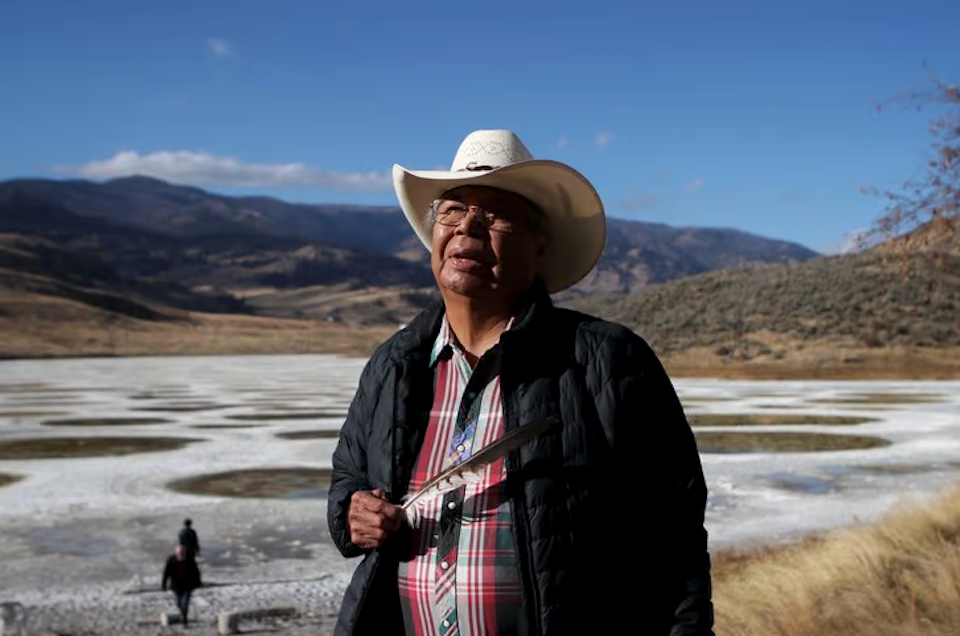cewel’na Leon Louis of the Lower Similkameen Indian Band unlocks the gate that keeps trespassers away from kłlilx’w (Spotted Lake), and then cautiously descends down a winding, brush-covered dirt path.
He stops in front of the small body of water, which resembles something from another planet with its chalky white surface dotted with colourful mineral deposits, and backed by the stark landscape of the Okanagan desert.
On a day in late October, Louis took a group of visitors from the nearby Osoyoos Lake Water Science Forum to see the site. The syilx Elder and knowledge keeper has spent decades taking syilx people down to kłlilx’w — located seven km west of sw̓iw̓s (Osoyoos) in syilx homelands — to help them heal, whether it be physically or spiritually.
“They’ll walk around the circle, and they’ll pray. They’ll tell the lake what sickness is bothering them. Cancer, diabetes, whatever it may be,” he said. “They’ll tell the lake what’s the matter, and one of those circles will say, ‘I am the one that will heal you.’”
For thousands of years, syilx people and other neighbouring First Nations have been visiting the sacred medicine lake for the physical and spiritual cures that it provides. Characterized by 365 naturally formed “spots,” kłlilx’w is home to a number of different minerals including magnesium, calcium and sulphur.
Louis said the seven minerals are usually only found separately in different parts of the world, but are all found together at kłlilx’w. In addition to those seven minerals, researchers have found that the lake’s conditions — with its extreme levels of sulphate salts — appear similar to what the landscape would have been on ancient Mars.
“We call the sky our father. This earth, our mother,” Louis said. “That’s where we came from.”
According to the Okanagan Geology Committee, the spots were formed by precipitation of sulphate salt, mainly in the form of gypsum and epsom salts, over thousands of years.
During the spring season, the spots at kłlilx’w are hidden and flooded by groundwater and runoff. As the summer progresses, the water evaporates to reveal the ridges of chemical deposits.
Before the Okanagan Nation Alliance (ONA) acquired ownership of kłlilx’w in 2001 — rightly returning its stewardship to the syilx people — Louis said that the lake was briefly owned by a non-Indigenous man who wanted to convert the area into a spa.
“Our Elders said, ‘No, you’re not making a spa out of it,’” said Louis. “[The former owner] said, ‘You Indians can’t tell me what I can or can’t do with my own land.’ We said, ‘This is our land.’”
Under possession of ONA, kłlilx’w is fenced off from the public, and permission is required to access the space. After several decades of advocacy work from syilx Elders and chiefs, ONA worked with the federal government to acquire the 56-acre kłlilx’w site, which is now protected and monitored by its original caretakers.
When the site was returned, Louis said that Elders could feel the presence of ancestors who had been coming to use the lake since time out of mind.
“When we got this back into our possession, when the Elders came here and we finished doing a burning ceremony, we went out there with all the people that were here and we circled the lake. They brought their drums and we sang,” said Louis.
However, although kłlilx’w is now under the careful protection of the Okanagan Nation Alliance, the site is now being impacted by the broader threat of climate change, which has been a challenge. Louis noted that for the first time in four or five years, he observed a noticeable decline in the lake’s water levels.
“Whereas before, when we first got it back, there was a creek that was going in there,” he said. “One of the ranchers owned the water rights and he diverted it away, so that’s when it started to go dry.”
Pollution from people passing by, and from homes that overlook the lake, is also a growing problem, he said.
“Before contact, when we came here, the Elders said there was kind of like a rainbow over the lake. It was beautiful, this beautiful rainbow over the lake,” he said. “But now, there’s so much pollution.”
Sometimes when he arrives at the gate, he said he’ll find stacks of garbage outside, and he has noticed a lack of respect for the site. Negative energy brought by some people to the territory, he emphasized, is also a form of pollution.
“People’s negative energy, their negative thoughts, their anger — it’s all affecting that lake,” he said. “The best way we can protect it now is fencing it. That’s why it’s fenced off. That’s why we put a padlock up there to lock that gate, because people always go down there. Again, that’s negative energy.”
He urged people to do their part to protect kłlilx’w, the surrounding land and nearby waters. Not just for themselves, but for the seven generations ahead.
“It’s getting harder and harder for us to gather our foods and medicines. It’s getting harder and harder for us to protect that water. But we do our best,” he said.
“It’s time to start working together to take care of this land for our children to come. It’s time.”
Reporting for this story was made possible in part through a grant from the Institute for Journalism and Natural Resources and the Gordon and Betty Moore Foundation.





